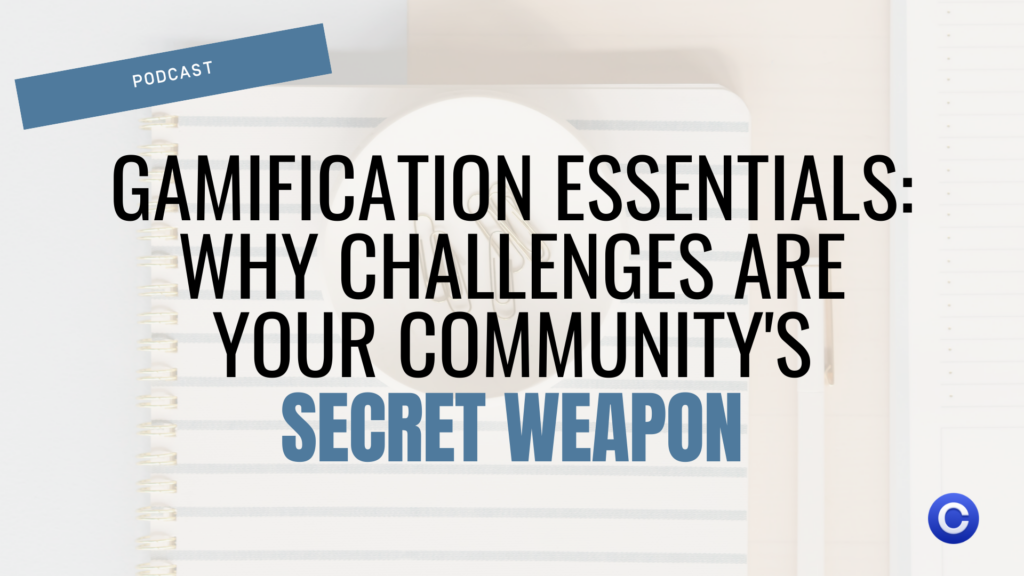🎧 Listen: Apple, Spotify, iHeart
Monday: 12 comments. Tuesday: 27 comments. Wednesday: 36 comments. Thursday: 54 comments. Friday: 89 comments and counting.
That’s what happened when Emma, one of my clients, ran her first community challenge after months of struggling with engagement. Before this, she was lucky to get five comments a week.
She had tried everything—thoughtful questions, valuable content, consistent posting—but nothing moved the needle until she introduced a simple five-day challenge.
The transformation wasn’t just in numbers. Suddenly, members who had never posted before were sharing their experiences. People were responding to each other, not just to Emma. And most surprisingly of all, when the challenge ended, the engagement continued.
What made the difference? It wasn’t luck or magic. It was the strategic use of gamification through a challenge.
What Gamification Really Is (And Isn’t)
When most people hear “gamification,” they picture leaderboards, points, and badges. While those are certainly elements of gamification, there’s so much more to it.
At its core, gamification is simply the application of game elements and game design techniques to non-game contexts. It’s about taking what makes games so engaging—progress tracking, sense of achievement, social interaction—and applying those principles to your community.
But here’s what gamification isn’t:
- It’s not just creating a game
- It’s not about turning everything into a competition
- It’s definitely not about manipulating your members
The best gamification feels natural and enhances the experience your community members are already having. It’s like adding spice to a dish—the right amount elevates everything without overpowering.
The Psychology Behind Why Gamification Works
Gamification works so well because it taps into three core psychological drivers:
- Our desire for achievement and progress: Humans are naturally goal-oriented. We love that dopamine hit that comes from checking things off a list, leveling up, or earning a reward. That’s why fitness trackers are so addictive—that little celebration when you hit your step goal isn’t just fun, it’s psychologically rewarding.
- Our need for social connection: We’re wired to want to belong, to be recognized, to share experiences with others. When we can see what others in our community are achieving, it motivates us to participate too.
- Our drive for autonomy and mastery: People love feeling in control and seeing themselves getting better at something. The right challenge gives members both a clear path and the freedom to tackle it in their own way.
You’ve experienced this yourself! Have you ever:
- Stuck with a workout longer because your fitness app was about to award you a badge?
- Gone out of your way to earn points from your favorite coffee shop?
- Felt motivated to finish a project because you could see how close you were to completion on a progress bar?
That’s gamification at work—and when you apply these principles to your community through challenges, magic happens.
Why Challenges Are the Perfect Gamification Tool
Unlike ongoing point systems or leaderboards that can sometimes feel overwhelming or never-ending, challenges have clear boundaries—a defined beginning and end, and specific goals. This structure is incredibly powerful for several reasons:
1. Challenges Create Urgency
When something is available for a limited time, people are more motivated to participate. It taps into our fear of missing out (FOMO). When you announce a five-day challenge, members know they have a specific window to participate, which motivates them to show up now rather than someday.
2. Challenges Provide Clarity
One of the biggest barriers to engagement is confusion about what to do or how to participate. A well-designed challenge makes it crystal clear: here’s what we’re doing, here’s how you participate, here’s what success looks like. That clarity removes friction and makes it easier for members to take action.
3. Challenges Create Shared Experiences
When your community goes through a challenge together, they connect with each other, share progress, cheer each other on, and build relationships. These relationships turn a group of individuals into a true community.
4. Challenges Turn Passive Members into Active Participants
We all know about the 90-9-1 rule: the idea that in most online communities, 90% of members are lurkers who never participate, 9% engage occasionally, and only 1% create content regularly. Challenges can flip that ratio by giving lurkers a specific, time-bound reason to participate.
Real-World Success Stories
Let me share a couple of success stories from clients who transformed their communities through challenges:
The Creative Entrepreneurs Community A client running a community for creative entrepreneurs was posting consistently, sharing valuable content, and asking questions—yet engagement was minimal. Members would join, look around, maybe like a post or two, and then disappear.
She implemented a simple five-day visibility challenge where members committed to showing up on social media in a specific way each day. They shared their posts in the community, gave each other feedback, and celebrated wins together.
The results? During those five days, community engagement increased by over 400%. Members who had never posted before were suddenly active daily. Even better, after the challenge ended, overall engagement remained 150% higher than before.
The Wellness Community Another client in the wellness space saw similar results with a morning routine challenge. What made this challenge special was that it wasn’t about competition—it was about personal improvement and mutual support.
Members shared their routines, struggles, and wins. They posted photos of their morning spaces and shared tips that worked for them.
By the end of the seven-day challenge, not only had engagement skyrocketed, but member retention improved dramatically in the following months. People who participated in the challenge were 70% more likely to renew their membership compared to those who didn’t participate.
Finding the Right Challenge for Your Community
Not all challenges work for all communities. The key is to align your challenge with what your members actually care about. Start by asking yourself these questions:
- What does my community want to achieve? What are their goals, aspirations, or pain points? The most effective challenges directly address something your members already want to do or learn.
- What skills are they trying to develop? Challenges that help people build or improve a specific skill tend to have high participation rates because they offer clear value.
- What constitutes a meaningful win for them? A good challenge has a reward that matters to participants. The satisfaction of achieving something important is often more motivating than any external reward.
- What’s a reasonable timeframe? For most communities, challenges between 5-10 days work best. Shorter than that, it’s hard to build momentum; longer than that, and people tend to drop off. But consider your specific audience—busy professionals might prefer a three-day challenge, while a community of hobbyists might engage with a 30-day adventure.
A Simple Framework for Identifying Challenge Ideas
- Listen to your members: What questions do they ask repeatedly? What goals do they mention? What struggles do they share? These are all potential challenge topics.
- Consider your expertise: What can you help them achieve that aligns with your strengths?
- Think about your community’s rhythm: When are your members most active? When do they have more time? Timing your challenge during these periods can significantly boost participation.
For example, if you run a community for entrepreneurs and notice members frequently asking about productivity, a five-day productivity reset challenge might be perfect. If you have a fitness community and members often discuss their struggles with consistency, a seven-day stretch challenge could be just what they need.
The key is to match the challenge to your community’s needs and desires. When you do that, participation feels like an obvious “yes” rather than a chore.
Common Pitfalls to Avoid
- Making the challenge too complicated: When participation requires too many steps or too much effort, people drop off quickly. Keep it simple, especially for your first challenge. One clear action per day is usually enough.
- Focusing too much on competition: While some communities thrive on competitive elements, most do better with challenges that emphasize personal improvement and mutual support.
- Choosing a topic that doesn’t align with your community’s interests: A brilliantly designed challenge on a topic no one cares about will still flop.
- Not providing enough support during the challenge: Challenges need energy and momentum. If you announce it and then disappear, engagement will fizzle. Plan to be present, cheering people on and acknowledging participation throughout.
- Failing to plan for what happens after the challenge ends: The end of a challenge is the perfect time to invite participants to take a next step with you, whether that’s joining a paid program, signing up for your next offering, or continuing to engage in the community in a new way.
Your Next Steps
Ready to transform your community with a challenge? Here’s a mini-challenge for you: brainstorm three possible challenge ideas. What could you help your members achieve in 5-7 days? What would get them excited to participate?
And if you want expert guidance every step of the way, join my 5-Day Challenge Creator Lab starting April 28th. During this live experience, I’ll walk you step by step through creating, promoting, and launching your own community challenge. You’ll finish with a complete challenge ready to implement—including daily prompts, emails, promotional strategy, and more.
Remember, your community is just one challenge away from transformation!
Join us for the next episode where we’ll dive deeper into challenge design—how to structure your challenge, create compelling daily prompts, and build in those gamification elements that keep people engaged throughout.

Resources & Links:
- Get started with a 14-Day FREE trial of Circle
- Kick start your community by joining The Strategic Community Co-Op
- Quick Wins for Circle Communities is our new YouTube series delivering actionable tips in bite-sized videos.
- Love my emails? Steal my secret weapon—Flodesk! Try it for free today.
- Your community deserves the best—so do you! Get The Scoop, my weekly newsletter packed with insights and strategies. Sign up today!






+ show Comments
- Hide Comments
add a comment